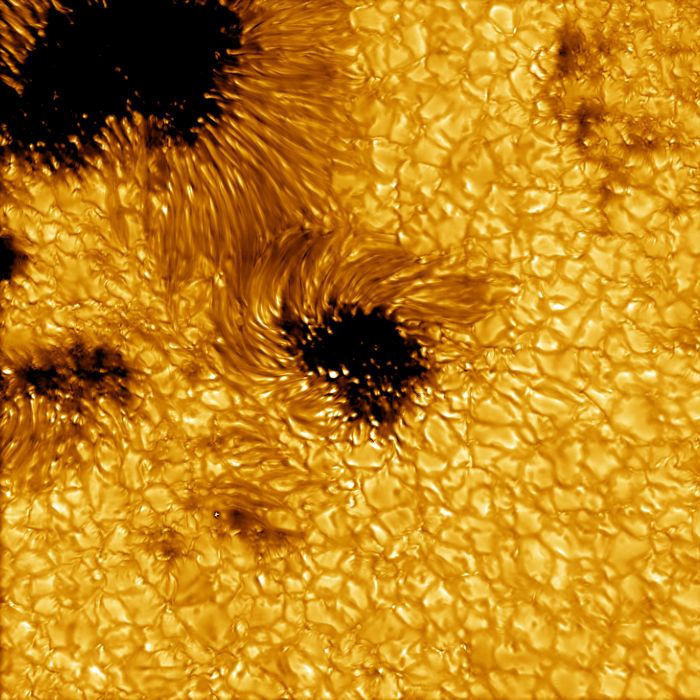This Mind-Bogglingly Gigantic Sunspot Is Roughly The Size of Our Entire Planet
A new telescope taking on the task of staring at the Sun has delivered incredible new images of solar activity.
The US National Science Foundation’s Daniel K. Inouye Solar Telescope commenced science operations for the first time on Wednesday 23 February 2022. It’s the largest solar telescope in the world, and its high-resolution observations of the solar corona will, scientists hope, greatly advance our understanding of our home star.
Inouye can image features as small as just 20 kilometers (12.4 miles) across.
From its vantage point near the summit of Haleakalā, Maui, following extensive testing and calibration, the instrument has begun a new era of solar science.
The newly released images are not the first we’ve seen from Inouye. Those arrived just over two years ago, and they’re truly breathtaking. However, now the telescope is delivering some close-up views of one of the most fascinating things our Sun does: sunspots.
Thanks to powerful technology and sophisticated processing @NSF‘s Inouye Solar Telescope has given the world a striking new sunspot image. With details as small as 20km across, the Inouye had its eyes on the #Sun as @NASASun PSP approached the corona #NSFFunded #ParkerPerihelion pic.twitter.com/AVI04zu5WK
— NatlSolarObservatory (@NatSolarObs) February 28, 2022
“Taking the first science observations with the Inouye Solar Telescope marks an exciting moment for the solar science community,” said astronomer Thomas Rimmele, director of the Inouye Solar Telescope.
“There is no other facility like the Inouye Solar Telescope. It is now the cornerstone of our mission to advance our knowledge of the Sun by providing forefront observational opportunities to the research community. It is a game changer.”
In the image above, released on Twitter, a sunspot is visible in spectacular detail. The dark region, known as the umbra, is roughly the diameter of Earth.
It was captured as the Parker Solar Probe approached the Sun for a flyby on February 25.
Inouye’s observations could combine with data captured by Parker for a more comprehensive range of data on solar phenomena.
Another image, snapped by Inouye in May of last year, shows a sunspot complex, the abyssal voids yawning into the camera’s eye.
 (NSO/AURA/NSF)
(NSO/AURA/NSF)
Science operations for the telescope will begin with a 12-month commissioning phase, which may include some issues that need to be resolved as the telescope is tested and calibrated under operational conditions.
It’s a good time for a solar telescope to come online, however. Inouye is designed to take measurements of solar phenomena such as sunspots, solar flares and coronal mass ejections, as well as the complicated solar magnetic field. And the Sun is getting rowdy.
There’s been a lot of sunspot activity in the last few months in the approach to solar maximum – the most active period in the Sun’s 11-year cycle. This cycle is based on the Sun’s magnetic field, which flips around every 11 years, with its north and south magnetic poles switching places.
The solar minimum – characterized by a minimal level of sunspot and flare activity – marks the end of one cycle and the beginning of a new one, and it occurs when the Sun’s magnetic field is at its weakest.
This is because the Sun’s magnetic field controls its activity: sunspots are temporary regions of strong magnetic fields, while coronal mass ejections that erupt from solar flares are produced by magnetic field lines snapping and reconnecting. The most recent minimum was in December 2019, and the next maximum is predicted for July 2025.
The first study selected for Inouye is an investigation into magnetic reconnection, which is when solar magnetic field lines snap and reconnect, releasing a vast burst of energy in the form of a coronal mass ejection.
“It is an honor to have been selected as the first science experiment executed at the Inouye Solar Telescope,” said study lead Tetsu Anan of the National Science Foundation.
“This a moment we’ve all looked forward to – a historic welcoming to the new age of solar observations. I’d like to thank the co-investigators and everyone involved with the Inouye Solar Telescope for this monumental milestone.”
The post This Mind-Bogglingly Gigantic Sunspot Is Roughly The Size of Our Entire Planet appeared first on Chop News.
from Chop News https://ift.tt/3b527q1
Post a Comment